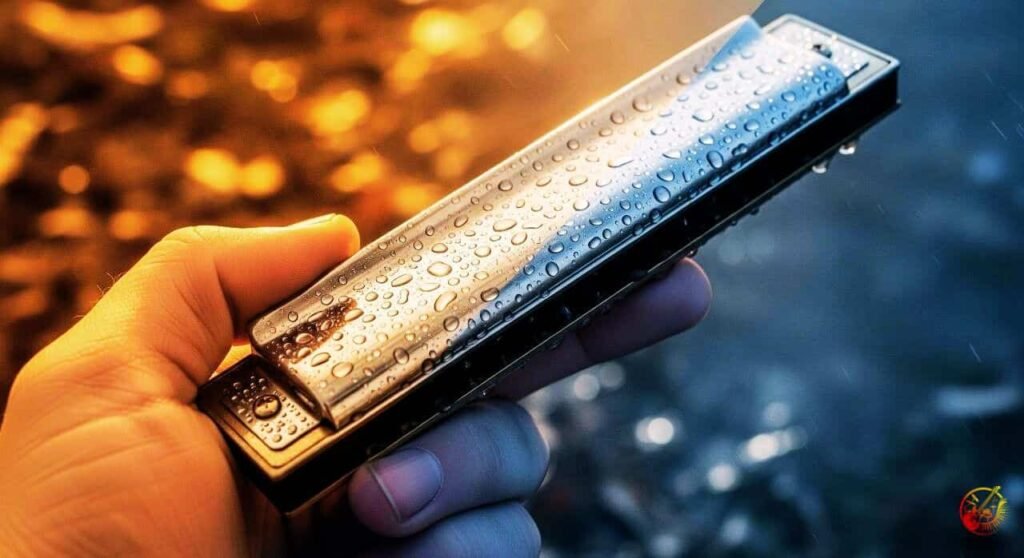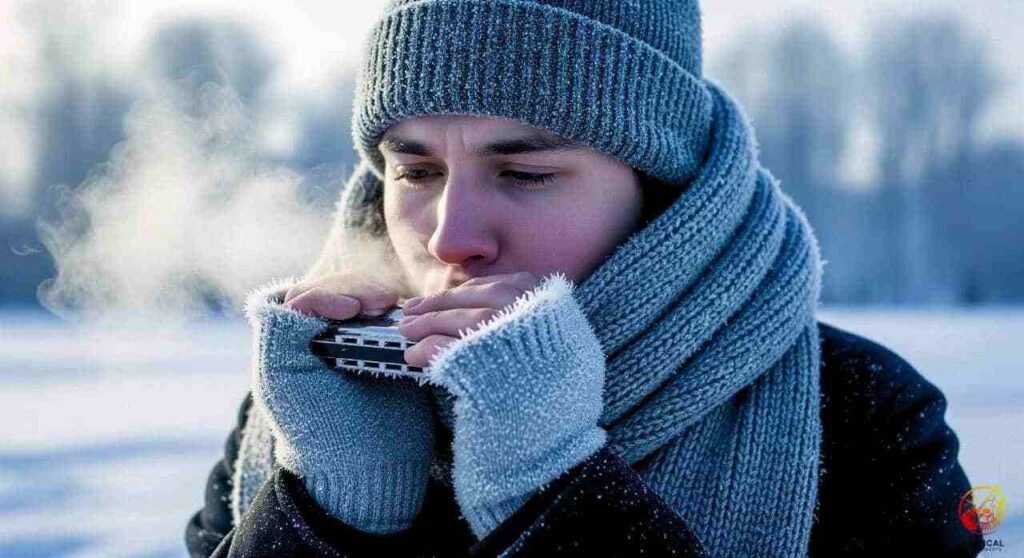Weather Affect on Harmonicas: How Climate Changes Impact Sound & Care
Weather affect on harmonicas is something every player notices sooner or later. A humid summer day, a freezing winter night, or even a sudden change in air pressure can change how your harmonica feels, sounds, and responds. You may find reeds sticking, wood swelling, or tuning drifting slightly off. These aren’t just minor annoyances, they can affect performance, maintenance, and the life span of your instrument.
In this guide, you’ll learn how different weather conditions, humidity, temperature, air pressure, and seasonal shifts, impact harmonicas. You’ll see how wood, metal, and plastic parts react to the environment and why some harmonicas survive harsh weather better than others.
I’ll share practical examples, troubleshooting steps, and tips for protecting your instrument whether you’re playing outdoors, traveling, or just storing it at home.
By the end, you’ll know how to handle climate challenges so your harmonica always performs at its best.
How does humidity affect a harmonica?

Humidity is one of the biggest enemies of harmonicas, especially those with wooden combs. When moisture levels in the air are high, wood absorbs water and swells. This can cause reeds to stick or misalign, leading to muffled sound and poor airflow. Players often notice this when practicing in tropical climates or during rainy seasons.
On the other hand, very dry air can make wooden combs shrink, creating tiny gaps between the reed plates and comb. Those gaps cause air leaks, which force you to blow harder and reduce responsiveness. Plastic and metal combs don’t swell or shrink as dramatically, but they can even collect condensation inside the chambers when humidity is high.
Example: If you play outdoors on a humid summer evening, your harmonica might feel sluggish within 30 minutes. The reeds collect condensation, and you may hear faint buzzing as moisture interferes with vibration.
Pro Tip: Always dry your harmonica after playing by tapping it gently and letting it air out before storing it in a case.
Does cold weather damage harmonicas?

Cold temperatures don’t just chill your fingers, they directly affect how harmonicas perform. Metal reeds contract in cold air, which can slightly shift their tuning. That means your harmonica may sound flat until it warms up to body temperature. If you play outside at a winter festival or street performance, you’ll likely notice sluggish reed response at first.
Another issue is condensation. When you blow warm breath into a cold harmonica, water droplets form quickly inside. This can freeze in extreme cases, making reeds stick completely. Over time, repeated exposure to freezing and thawing can stress the reed plates and comb joints.
Example: Street performers in northern Europe often keep spare harmonicas in inside pockets during winter. This keeps them warm enough to avoid freezing moisture problems during sets.
Expert Insight: “Never leave your harmonica in a freezing car overnight,” says repair technician Brendan Power. “The temperature shock can warp wood combs and weaken reed rivets.”
Can heat affect tuning and playability?
Yes, heat can be just as harmful as cold. In hot weather, metal reeds expand, which can cause slight tuning changes. If the reeds expand unevenly, they may rattle or buzz. Plastic combs also soften slightly in high heat, which can make reed plates shift if the harmonica is poorly sealed.
For wooden harmonicas, heat combined with dryness is a recipe for cracking. Many vintage models stored in attics or near radiators end up with warped combs or separated reed plates. Even modern instruments can lose airtightness in hot environments.
Example: A harmonica left in direct sunlight inside a car on a 35°C (95°F) day can heat to over 60°C (140°F). The reeds may go temporarily sharp, and the comb may warp permanently if left too long.
Pro Tip: Always store your harmonica in a shaded, cool place. Carrying a small case with climate padding can save your instrument from heat stress.
How does air pressure or altitude affect harmonicas?

Air pressure plays a subtle but important role in harmonica performance. At higher altitudes, air density decreases, meaning less oxygen moves across the reeds. This makes the harmonica feel less responsive, you have to blow or draw harder to get the same volume. Some players also notice tone changes, as reeds vibrate differently in thin air.
Example: A player traveling from sea level to Denver (altitude ~1,600m) may feel their harmonica suddenly “loses power.” The reeds are fine, but the thin air reduces efficiency. Performers touring in mountainous areas often bring several harmonicas and adjust their playing style to compensate.
Interestingly, high air pressure (before a storm, for instance) can make reeds sound slightly more resonant because the denser air enhances vibration. While this isn’t as noticeable as altitude effects, some players swear they hear tonal differences linked to pressure shifts.
Expert Insight: “Your body adjusts to altitude over days, but your harmonica doesn’t. It will always play weaker at high elevation,” explains harmonica coach David Barrett.
Can weather shorten the lifespan of a harmonica?
Yes, weather directly impacts how long a harmonica lasts. Reeds wear out faster when exposed to repeated cycles of moisture and dryness. Corrosion also sets in quickly when condensation lingers on metal. Wooden combs, once warped or cracked, are difficult to repair, shortening the instrument’s usable life.
However, careful storage and routine cleaning can extend lifespan dramatically. A harmonica exposed to sweaty summer gigs and freezing winter travel but properly cared for might last 5–7 years. Neglect the same instrument, and it may fail within a year.
Example: Touring musicians often rotate multiple harmonicas, not just for keys but to give each instrument time to dry and stabilize between shows. This strategy reduces stress from weather extremes.
Pro Tip: Treat your harmonica like a fine acoustic guitar. You wouldn’t leave a guitar in a hot trunk or damp basement, apply the same logic to harmonicas if you want them to last.
Do harmonicas rust in rainy or damp weather?

Yes, harmonicas can rust if exposed to rainy or damp conditions for extended periods. The reeds and reed plates are typically made of brass, phosphor bronze, or stainless steel. Brass is more resistant to corrosion, but stainless steel holds up best in wet conditions. If your harmonica gets damp and you don’t dry it properly, rust or tarnish can build up on the reeds, slowing their vibration and shortening their life.
Example: Outdoor buskers in rainy climates often face this issue. Playing under shelter still exposes the harmonica to damp air, and without careful drying, rust spots form on reeds within weeks.
Pro Tip: If you live in a coastal or rainy region, always keep silica gel packs in your harmonica case. They help absorb excess moisture and slow down corrosion.
Can weather affect your playing technique?
Yes, weather doesn’t only change the harmonica, it also changes how you need to play. In cold weather, reeds respond slower, so you may need lighter breath to avoid overblowing.
In dry climates, you may need more frequent breaks to keep your mouth and breath moist, since dry reeds respond less smoothly.
In humid conditions, you may need to clear moisture buildup more often.
Example: Outdoor performers in summer often tilt the harmonica slightly downward while playing. This lets condensation drip out instead of collecting inside the chambers.
Pro Tip: Always listen to how the instrument responds in the moment. If reeds feel stiff or sluggish, adjust breath force and playing style instead of forcing sound. Weather responsive technique saves wear and tear on the reeds.
Are some harmonicas more weather-resistant than others?
Not all harmonicas handle weather the same way. The materials used in the comb, reed plates, and covers make a big difference in resilience.
Here’s a breakdown:
| Harmonica Type | Strength in Weather | Weakness in Weather |
|---|---|---|
| Wood comb | Warm tone, traditional feel | Swells in humidity, cracks in dryness |
| Plastic comb | Stable in most climates | Can warp in extreme heat |
| Metal comb | Very durable, resists swelling | Heavier, can feel cold to play |
Example: A Hohner Marine Band with pearwood comb is more sensitive to rain and humidity than a Suzuki Promaster with an aluminum comb. Travelers often prefer plastic or metal combs because they’re easier to maintain in shifting climates.
Pro Tip: If you love wood combs for their tone but live in a humid area, look for sealed or laminated models. These resist swelling far better than raw wood designs.
What’s the best way to protect harmonicas in changing weather?
Caring for your harmonica in shifting weather isn’t complicated, but consistency matters.
First, always store it in a case that shields against temperature swings. Soft pouches offer little protection; hard-shell cases with lining are better.
Second, never play immediately after moving from extreme cold to warm indoors. Let the instrument adjust for 10–15 minutes before using it. This prevents sudden condensation shock.
Third, wipe down your harmonica after playing. Even in dry climates, moisture from your breath can linger inside. Tapping it gently against your hand removes droplets and reduces rust risk.
Quick Care Routine by Climate
| Climate | Main Risk | Best Practice |
|---|---|---|
| Humid tropics | Swelling, sticking reeds | Dry thoroughly, use sealed combs |
| Dry deserts | Shrinking wood, cracks | Keep in humidified case |
| Cold winters | Condensation, freezing | Warm harmonica before playing |
| Hot summers | Warping, tuning drift | Store in shaded case |
Expert Insight: Many professional players carry silica gel packs in their cases for humidity control and small humidifiers for desert climates.
Final Thoughts
Weather affect on harmonicas goes far beyond casual inconvenience. Humidity swells wood and sticks reeds. Cold slows response and causes condensation. Heat warps combs and shifts tuning. Altitude drains power. Rain risks rust. Even traveling between climates introduces stress that can shorten your instrument’s life.
But the weather doesn’t have to ruin your music. With the right storage, careful maintenance, and small adjustments in playing technique, your harmonica can thrive in almost any condition. Use cases with climate control, dry or humidify depending on region, and give your instrument time to adjust when moving between environments.
Every harmonica tells a story, not just through music but through how it survives its climate. The next time you step on stage, whether under hot lights or in chilly air, remember: weather is your silent duet partner. Play with it, not against it.
FAQ: Weather Affect on Harmonicas
1. Does humidity ruin a harmonica?
High humidity can cause wooden combs to swell and reeds to stick, which reduces responsiveness. While it won’t “ruin” a harmonica instantly, long-term exposure without proper drying can lead to permanent warping and air leaks.
2. Can cold weather make harmonica reeds crack?
Cold alone won’t crack reeds, but rapid freezing and thawing cycles can stress the metal over time. The bigger risk is condensation freezing inside, which causes reeds to stick or bend.
3. How does hot weather affect harmonica tuning?
In hot conditions, metal reeds expand slightly, which can push tuning sharp. Heat can also soften plastic combs or dry out wooden ones, leading to warping and tuning instability.
4. Do harmonicas rust in damp weather?
Yes. Reeds made of brass or steel can rust or tarnish if left damp for too long. Rust slows reed vibration and shortens instrument life, especially in coastal or rainy regions.
5. Why does my harmonica sound weak at high altitude?
Thin air at high altitudes reduces air density, so reeds don’t vibrate as efficiently. This makes the harmonica feel less powerful and forces you to adjust breath control.
6. Which harmonicas are best for extreme weather?
Plastic and metal comb harmonicas are more weather-resistant than wood comb models. Sealed wooden combs are also good options if you prefer traditional tone but need better durability.
7. Should I store my harmonica with a humidifier or dehumidifier?
It depends on your climate. Use a dehumidifier or silica gel in humid regions to prevent rust. In dry climates, a small case humidifier helps prevent wood from shrinking or cracking.
8. Can sudden weather changes damage a harmonica?
Yes. Moving quickly between hot, cold, humid, or dry environments can stress the reeds and comb. Allowing your harmonica to acclimate slowly reduces the risk of swelling, shrinking, or condensation damage.
